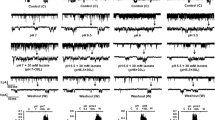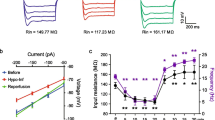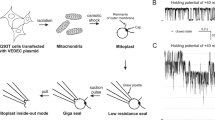Abstract
TREK-1, a two-pore domain potassium channel, responds to ischemic levels of intracellular lactate and acidic pH to provide neuroprotection. There are two splice variants of hTREK1: the shorter splice variant having a shorter N-terminus compared with the full-length hTREK1 with similar C-terminus sequence that is widely expressed in the brain. The shorter variant was reported to be irresponsive to hypoxia—a condition attributed to ischemia, which has put the neuroprotective role of hTREK-1 channel into question. Since interaction between N- and C-terminus of different ion channels shapes their gating, we re-examined the sensitivity of the full-length as well as the shorter hTREK-1 channel to intracellular hypoxia along with lactate. Single-channel data obtained from the excised inside-out patches of the full-length channel expressed in HEK293 cells indicated an increase in activity as opposed to a decrease in activity in the shorter isoform. However, both the isoforms showed an increase in activity under combined hypoxia, 20mM lactate, and low pH 6 condition, albeit with subtle differences in their individual actions, confirming the neuroprotective role played by hTREK-1 irrespective of the differences in the N-terminus among the splice variants. Furthermore, E321A mutant that disrupts the interaction of the C-terminus with the membrane showed a decrease in activity with hypoxia indicating the importance of the C-terminus in the hypoxic response of the full-length hTREK-1. We propose an increase in activity of both the splice variants of hTREK-1 in combined hypoxia, high lactate, and low pH conditions typically associated with ischemia provides neuroprotection.








Similar content being viewed by others
Data availability
The data that support the findings of this study are available on request from the corresponding author. The data are not publicly available due to privacy or ethical restriction.
References
Abi-Gerges N, Holkham H, Jones EMC, Pollard CE, Valentin JP, Robertson GA (2011) HERG subunit composition determines differential drug sensitivity. Br J Pharmacol 164:419–432. https://doi.org/10.1111/j.1476-5381.2011.01378.x
Acker T, Acker H (2004) Cellular oxygen sensing need in CNS function: physiological and pathological implications. J Exp Biol 207:3171–3188. https://doi.org/10.1242/jeb.01075
Baez-Nieto D, Castillo JP, Dragicevic C, Alvarez O, Latorre R (2011) Thermo-TRP channels: biophysics of polymodal receptors. In: Advances in Experimental Medicine and Biology, pp 469–490
Bagriantsev SN, Peyronnet R, Clark KA, Honoré E, Minor DL (2011) Multiple modalities converge on a common gate to control K2P channel function. EMBO J 30:3594–3606. https://doi.org/10.1038/emboj.2011.230
Bagriantsev SN, Clark KA, Minor DL (2012) Metabolic and thermal stimuli control K 2P 2.1 (TREK-1) through modular sensory and gating domains. EMBO J 31:3297–3308. https://doi.org/10.1038/emboj.2012.171
Banerjee A, Ghatak S, Sikdar SK (2016) L -lactate mediates neuroprotection against ischaemia by increasing TREK1 channel expression in rat hippocampal astrocytes in vitro. J Neurochem 138:265–281. https://doi.org/10.1111/jnc.13638
Berthet C, Lei H, Thevenet J, Gruetter R, Magistretti PJ, Hirt L (2009) Neuroprotective role of lactate after cerebral ischemia. J Cereb Blood Flow Metab 29:1780–1789. https://doi.org/10.1038/jcbfm.2009.97
Berthet C, Castillo X, Magistretti PJ, Hirt L (2012) New evidence of neuroprotection by lactate after transient focal cerebral ischaemia: extended benefit after intracerebroventricular injection and efficacy of intravenous administration. Cerebrovasc Dis 34:329–335. https://doi.org/10.1159/000343657
Brauchi S, Orio P, Latorre R (2004) Clues to understanding cold sensation: thermodynamics and electrophysiological analysis of the cold receptor TRPM8. Proc Natl Acad Sci U S A 101:15494–15499. https://doi.org/10.1073/pnas.0406773101
Brelidze TI (2019) N-and C-terminal interactions in KCNH channels: the spotlight on the intrinsic ligand. J Gen Physiol 151:400–403. https://doi.org/10.1085/jgp.201812313
Brenker C, Goodwin N, Weyand I, Kashikar ND, Naruse M, Krähling M, Müller A, Benjamin Kaupp U, Strünker T (2012) The CatSper channel: a polymodal chemosensor in human sperm. EMBO J 31:1654–1665. https://doi.org/10.1038/emboj.2012.30
Buckler KJ (2015) TASK channels in arterial chemoreceptors and their role in oxygen and acid sensing. Pflugers Arch 467:1013–1025. https://doi.org/10.1007/s00424-015-1689-1
Buckler KJ, Honoré E (2005) The lipid-activated two-pore domain K + channel TREK-1 is resistant to hypoxia: implication for ischaemic neuroprotection. J Physiol 562:213–222. https://doi.org/10.1113/jphysiol.2004.077503
Caley AJ, Gruss M, Franks NP (2005) The effects of hypoxia on the modulation of human TREK-1 potassium channels. J Physiol 562:205–212. https://doi.org/10.1113/jphysiol.2004.076240
Campanucci VA, Brown ST, Hudasek K, O’Kelly IM, Nurse CA, Fearon IM (2005) O2 sensing by recombinant TWIK-related halothane-inhibitable K+ channel-1 background K+ channels heterologously expressed in human embryonic kidney cells. Neuroscience 135:1087–1094. https://doi.org/10.1016/j.neuroscience.2005.07.009
Cervós-Navarro J, Diemer NH (1991) Selective vulnerability in brain hypoxia. Crit Rev Neurobiol 6:149–182
Chemin J, Patel AJ, Duprat F, Lauritzen I, Lazdunski M, Honoré E (2005) A phospholipid sensor controls mechanogating of the K+ channel TREK-1. EMBO J 24:44–53. https://doi.org/10.1038/sj.emboj.7600494
Choudhury N, Sikdar SK (2018) 17β-estradiol potentiates TREK1 channel activity through G protein-coupled estrogen receptor. J Steroid Biochem Mol Biol 183:94–105. https://doi.org/10.1016/j.jsbmb.2018.06.001
Codding SJ, Trudeau MC (2019) The hERG potassium channel intrinsic ligand regulates N- and C-terminal interactions and channel closure. J Gen Physiol 151:478–488. https://doi.org/10.1085/jgp.201812129
Conforti L, Bodi I, Nisbet JW, Millhorn DE (2000) O2-sensitive K+ channels: role of the Kv1.2 α-subunit in mediating the hypoxic response. J Physiol 524:783–793. https://doi.org/10.1111/j.1469-7793.2000.00783.x
Gebremedhin D, Bonnet P, Greene AS, England SK, Rusch NJ, Lombard JH, Harder DR (1994) Hypoxia increases the activity of Ca2+−sensitive K+ channels in cat cerebral arterial muscle cell membranes
Ghatak S, Sikdar SK (2016) Lactate modulates the intracellular pH sensitivity of human TREK1 channels. Pflugers Arch Eur J Physiol 468:825–836. https://doi.org/10.1007/s00424-016-1795-8
Ghatak S, Banerjee A, Sikdar SK (2016) Ischaemic concentrations of lactate increase TREK1 channel activity by interacting with a single histidine residue in the carboxy terminal domain. J Physiol 594:59–81. https://doi.org/10.1113/JP270706
Glenn TC, Martin NA, Horning MA, McArthur DL, Hovda DA, Vespa P, Brooks GA (2015) Lactate: brain fuel in human traumatic brain injury: a comparison with normal healthy control subjects. J Neurotrauma 32:820–832. https://doi.org/10.1089/neu.2014.3483
Hammarström AKM, Gage PW (2000) Oxygen-sensing persistent sodium channels in rat hippocampus. J Physiol 529:107–118. https://doi.org/10.1111/j.1469-7793.2000.00107.x
Heurteaux C, Guy N, Laigle C, Blondeau N, Duprat F, Mazzuca M, Lang-Lazdunski L, Widmann C, Zanzouri M, Romey G, Lazdunski M (2004) TREK-1, a K+ channel involved in neuroprotection and general anesthesia. EMBO J 23:2684–2695. https://doi.org/10.1038/sj.emboj.7600234
Honoré E (2007) The neuronal background K2P channels: focus on TREK1. Nat Rev Neurosci 8:251–261. https://doi.org/10.1038/nrn2117
Honoré E, Maingret F, Lazdunski M, Patel AJ (2002) An intracellular proton sensor commands lipid- and mechano-gating of the K+ channel TREK-1. EMBO J 21:2968–2976. https://doi.org/10.1093/emboj/cdf288
Hope PL, Cady EB, Delpy DT, Ives NK, Gardiner RM, Reynolds EOR (1988) Brain metabolism and intracellular pH during Ischaemia: effects of systemic glucose and bicarbonate administration studied by 31P and 1H nuclear magnetic resonance spectroscopy in vivo in the lamb. J Neurochem 50:1394–1402. https://doi.org/10.1111/j.1471-4159.1988.tb03022.x
Horrigan FT, Heinemann SH, Hoshi T (2005) Heme regulates allosteric activation of the Slo1 BK channel. J Gen Physiol 126:7–21. https://doi.org/10.1085/jgp.200509262
Jaggar JH, Li A, Parfenova H, Liu J, Umstot ES, Dopico AM, Leffler CW (2005) Heme is a carbon monoxide receptor for large-conductance Ca 2+−activated K+ channels. Circ Res 97:805–812. https://doi.org/10.1161/01.RES.0000186180.47148.7b
Jiang C, Haddad GG (1994) Oxygen deprivation inhibits a K+ channel independently of cytosolic factors in rat central neurons. J Physiol 481:15–26. https://doi.org/10.1113/jphysiol.1994.sp020415
Jokivarsi KT, Gröhn HI, Gröhn OH, Kauppinen RA (2007) Proton transfer ratio, lactate, and intracellular pH in acute cerebral ischemia. Magn Reson Med 57:647–653. https://doi.org/10.1002/mrm.21181
Kapetanaki SM, Burton MJ, Basran J, Uragami C, Moody PCE, Mitcheson JS, Schmid R, Davies NW, Dorlet P, Vos MH, Storey NM, Raven E (2018) A mechanism for CO regulation of ion channels. Nat Commun 9:907. https://doi.org/10.1038/s41467-018-03291-z
Kemp PJ, Peers C, Lewis A, Miller P (2004) Regulation of recombinant human brain tandem P domain K+ channels by hypoxia: a role for O2 in the control of neuronal excitability? J Cell Mol Med 8:38–44. https://doi.org/10.1111/j.1582-4934.2004.tb00258.x
Kim Y, Gnatenco C, Bang H, Kim D (2001) Localization of trek-2 k+channel domains that regulate channel kinetics and sensitivity to pressure, fatty acids and phi. Pflugers Arch Eur J Physiol 442:952–960. https://doi.org/10.1007/s004240100626
Kisselbach J, Seyler C, Schweizer PA, Gerstberger R, Becker R, Katus HA, Thomas D (2014) Modulation of K2P2.1 and K2P10.1 K+ channel sensitivity to carvedilol by alternative mRNA translation initiation. Br J Pharmacol 171:5182–5194. https://doi.org/10.1111/bph.12596
Klabunde RE (2003) Cardiovascular physiology concepts. Lippincott Williams & Wilkins
Kline DD, Buniel MCF, Glazebrook P, Peng YJ, Ramirez-Navarro A, Prabhakar NR, Kunze DL (2005) Kv1.1 deletion augments the afferent hypoxic chemosensory pathway and respiration. J Neurosci 25:3389–3399. https://doi.org/10.1523/JNEUROSCI.4556-04.2005
Lauritzen I (2000) Polyunsaturated fatty acids are potent neuroprotectors. EMBO J 19:1784–1793. https://doi.org/10.1093/emboj/19.8.1784
Lewis A, Peers C, Ashford MLJ, Kemp PJ (2002) Hypoxia inhibits human recombinant large conductance, Ca2+−activated K+ (maxi-K) channels by a mechanisms which is membrane delimited and Ca2+ sensitive. J Physiol 540:771–780. https://doi.org/10.1113/jphysiol.2001.013888
Li T, Bonkovsky HL (2010) Guo JT (2010) structural analysis of heme proteins: implication for design and prediction. IEEE Int Conf Bioinforma Biomed Work BIBMW 2010:834–835. https://doi.org/10.1109/BIBMW.2010.5703932
Li Z-B, Zhang HX, Li LL, Wang XL (2005) Enhanced expressions of arachidonic acid-sensitive tandem-pore domain potassium channels in rat experimental acute cerebral ischemia. Biochem Biophys Res Commun 327:1163–1169. https://doi.org/10.1016/j.bbrc.2004.12.124
Lolicato M, Riegelhaupt PM, Arrigoni C, Clark KA, Minor DL (2014) Transmembrane helix straightening and buckling underlies activation of mechanosensitive and thermosensitive K2P channels. Neuron 84:1198–1212. https://doi.org/10.1016/j.neuron.2014.11.017
Lolicato M, Arrigoni C, Mori T, Sekioka Y, Bryant C, Clark KA, Minor DL (2017) K2P2.1 (TREK-1)-activator complexes reveal a cryptic selectivity filter binding site. Nature 547:364–368. https://doi.org/10.1038/nature22988
López-Barneo J (1994) Oxygen-sensitive ion channels: how ubiquitous are they? Trends Neurosci 17:133–135. https://doi.org/10.1016/0166-2236(94)90084-1
López-Barneo J, Pardal R, Ortega-Sáenz P (2001) Cellular mechanism of oxygen sensing. Annu Rev Physiol 63:259–287. https://doi.org/10.1146/annurev.physiol.63.1.259
Maingret F, Patel AJ, Lesage F, Lazdunski M, Honoré E (1999) Mechano- or acid stimulation, two interactive modes of activation of the TREK-1 potassium channel. J Biol Chem 274:26691–26696. https://doi.org/10.1074/jbc.274.38.26691
McClenaghan C, Schewe M, Aryal P, Carpenter EP, Baukrowitz T, Tucker SJ (2016) Polymodal activation of the TREK-2 K2P channel produces structurally distinct open states. J Gen Physiol 147:497–505. https://doi.org/10.1085/jgp.201611601
Michiels C (2004) Physiological and pathological responses to hypoxia. Am J Pathol 164:1875–1882. https://doi.org/10.1016/S0002-9440(10)63747-9
Miller P, Kemp PJ, Lewis A, Chapman CG, Meadows HJ, Peers C (2003) Acute hypoxia occludes hTREK-1 modulation: re-evaluation of the potential role of tandem P domain K+ channels in central neuroprotection. J Physiol 548:31–37
Miller P, Kemp PJ, Lewis A, Chapman CG, Meadows HJ, Peers C (2003) Rapid Report. J Physiol 548:31–37. https://doi.org/10.1111/j.1469-7793.2003.00031.x
Miller P, Kemp PJ, Peers C (2005) Structural requirements for O2 sensing by the human tandem-P domain channel, hTREK1. Biochem Biophys Res Commun 331:1253–1256. https://doi.org/10.1016/j.bbrc.2005.04.042
Mojet MH, Mills E, Duchen MR (1997) Hypoxia-induced catecholamine secretion in isolated newborn rat adrenal chromaffin cells is mimicked by inhibition of mitochondrial respiration. J Physiol 504:175–189. https://doi.org/10.1111/j.1469-7793.1997.175bf.x
Nilius B, Voets T, Muallem, Hardie, Fleig (2004) Diversity of TRP channel activation. In: Novartis Foundation Symposium. pp. 140–154
Noël J, Sandoz G, Lesage F (2011) Molecular regulations governing TREK and TRAAK channel functions. Channels (Austin) 5:402–409. https://doi.org/10.4161/chan.5.5.16469
Numata T, Ogawa N, Takahashi N, Mori Y (2013) TRP channels as sensors of oxygen availability. Pflugers Arch - Eur J Physiol 465:1075–1085. https://doi.org/10.1007/s00424-013-1237-9
Otsuguro KI, Tang J, Tang Y, Xiao R, Freichel M, Tsvilovskyy V, Ito S, Flockerzi V, Zhu MX, Zholos AV (2008) Isoform-specific inhibition of TRPC4 channel by phosphatidylinositol 4,5-bisphosphate. J Biol Chem 283:10026–10036. https://doi.org/10.1074/jbc.M707306200
Pacifici RE, Davies KJA (1991) Protein, lipid and DNA repair systems in oxidative stress: the free-radical theory of aging revisited. Gerontology 37:166–180. https://doi.org/10.1159/000213257
Patel AJ, Honoré E (2001) Properties and modulation of mammalian 2P domain K+ channels
Phillis JW, Song D, Guyot LL, O’Regan MH (1999) Lactate reduces amino acid release and fuels recovery of function in the ischemic brain. Neurosci Lett 272:195–198. https://doi.org/10.1016/S0304-3940(99)00584-4
Plant LD, Kemp PJ, Peers C, Henderson Z, Pearson HA (2002) Hypoxic depolarization of cerebellar granule neurons by specific inhibition of TASK-1. Stroke 33:2324–2328. https://doi.org/10.1161/01.STR.0000027440.68031.B0
Prior S, Kim A, Yoshihara T, Tobita S, Takeuchi T, Higuchi M (2014) Mitochondrial respiratory function induces endogenous hypoxia. PLoS One 9:e88911. https://doi.org/10.1371/journal.pone.0088911
Renigunta V, Schlichthörl G, Daut J (2015) Much more than a leak: structure and function of K2P-channels. Pflugers Arch - Eur J Physiol 467:867–894. https://doi.org/10.1007/s00424-015-1703-7
Rink C, Khanna S (2011) Significance of brain tissue oxygenation and the arachidonic acid cascade in stroke
Rinné S, Renigunta V, Schlichthörl G, Zuzarte M, Bittner S, Meuth SG, Decher N, Daut J, Preisig-Müller R (2014) A splice variant of the two-pore domain potassium channel TREK-1 with only one pore domain reduces the surface expression of full-length TREK-1 channels. Pflugers Arch Eur J Physiol 466:1559–1570. https://doi.org/10.1007/s00424-013-1384-z
Robinson SR, Dang TN, Dringen R, Bishop GM (2009) Hemin toxicity: a preventable source of brain damage following hemorrhagic stroke. Redox Rep 14:228–235. https://doi.org/10.1179/135100009X12525712409931
Sahoo N, Goradia N, Ohlenschläger O, Schönherr R, Friedrich M, Plass W, Kappl R, Hoshi T, Heinemann SH (2013) Heme impairs the ball-and-chain inactivation of potassium channels. Proc Natl Acad Sci U S A 110:E4036–E4044. https://doi.org/10.1073/pnas.1313247110
Sandoz G, Bell SC, Isacoff EY (2011) Optical probing of a dynamic membrane interaction that regulates the TREK1 channel. Proc Natl Acad Sci U S A 108:2605–2610. https://doi.org/10.1073/pnas.1015788108
Schurr A, Payne RS, Miller JJ, Rigor BM (1997) Brain lactate, not glucose, fuels the recovery of synaptic function from hypoxia upon reoxygenation: an in vitro study. Brain Res 744:105–111. https://doi.org/10.1016/S0006-8993(96)01106-7
Schurr A, Payne RS, Miller JJ, Tseng MT, Rigor BM (2001) Blockade of lactate transport exacerbates delayed neuronal damage in a rat model of cerebral ischemia. Brain Res 895:268–272. https://doi.org/10.1016/S0006-8993(01)02082-0
Thomas D, Plant LD, Wilkens CM, Mccrossan ZA, Steve AN (2008) Potassium Channels Permeable To Sodium. 58:859–870. https://doi.org/10.1016/j.neuron.2008.04.016.Alternative
Thompson RJ, Nurse CA (1998) Anoxia differentially modulates multiple K+ currents and depolarizes neonatal rat adrenal chromaffin cells. J Physiol 512:421–434. https://doi.org/10.1111/j.1469-7793.1998.421be.x
Veale EL, Rees KA, Mathie A, Trapp S (2010) Dominant negative effects of a non-conducting TREK1 splice variant expressed in brain. J Biol Chem 285:29295–29304. https://doi.org/10.1074/jbc.M110.108423
Veale EL, Al-Moubarak E, Bajaria N, Omoto K, Cao L, Tucker SJ, Stevens EB, Mathie A (2014) Influence of the N terminus on the biophysical properties and pharmacology of TREK1 potassium channels. Mol Pharmacol 85:671–681. https://doi.org/10.1124/mol.113.091199
Voets T, Owsianik G, Janssens A, Talavera K, Nilius B (2007) TRPM8 voltage sensor mutants reveal a mechanism for integrating thermal and chemical stimuli. Nat Chem Biol 3:174–182. https://doi.org/10.1038/nchembio862
Wang M, Song J, Xiao W, Yang L, Yuan J, Wang W, Yu Z, Xie M (2012) Changes in lipid-sensitive two-pore domain potassium channel TREK-1 expression and its involvement in astrogliosis following cerebral ischemia in rats. J Mol Neurosci 46:384–392. https://doi.org/10.1007/s12031-011-9598-z
Wang JJ, Liu F, Yang F, Wang YZ, Qi X, Li Y, Hu Q, Zhu MX, Le Xu T (2020) Disruption of auto-inhibition underlies conformational signaling of ASIC1a to induce neuronal necroptosis. Nat Commun 11:1–12. https://doi.org/10.1038/s41467-019-13873-0
Weir EK, Archer SL (1995) The mechanism of acute hypoxic pulmonary vasoconstriction: the tale of two channels. FASEB J 9:183–189. https://doi.org/10.1096/fasebj.9.2.7781921
Wolff SP, Garner A, Dean RT (1986) Free radicals, lipids and protein degradation. Trends Biochem Sci 11:27–31. https://doi.org/10.1016/0968-0004(86)90228-8
Wright PD, McCoull D, Walsh Y, Large JM, Hadrys BW, Gaurilcikaite E, Byrom L, Veale EL, Jerman J, Mathie A (2019) Pranlukast is a novel small molecule activator of the two-pore domain potassium channel TREK2. Biochem Biophys Res Commun 520:35–40. https://doi.org/10.1016/j.bbrc.2019.09.093
Yang SB, Jan LY (2008) Thrilling moment of an inhibitory channel. Neuron 58:823–824. https://doi.org/10.1016/j.neuron.2008.06.003
Yoshida S, Busto R, Martinez E, Scheinberg P, Ginsberg MD (1985) Regional brain energy metabolism after complete versus incomplete ischemia in the rat in the absence of severe lactic acidosis. J Cereb Blood Flow Metab 5:490–501. https://doi.org/10.1038/jcbfm.1985.75
Zheng J (2013) Domain-domain interactions in ion channels. J Gen Physiol 142:347–350. https://doi.org/10.1085/jgp.201311090
Zhu WH, Conforti L, Czyzyk-Krzeska MF, Millhorn DE (1996) Membrane depolarization in PC-12 cells during hypoxia is regulated by an O2-sensitive K+ current. Am J Phys Cell Phys 271:C658–C665. https://doi.org/10.1152/ajpcell.1996.271.2.c658
Acknowledgements
We thank Prof. Steve A.N Goldstein of Yale University and Dr. Delphine Bichet of IPMC, Nice, France, for kindly donating pRAT-hTREK-1 plasmid and pIRES2-hTREK1a plasmids respectively.
Funding
The research was funded by the Department of Biotechnology, Ministry of Science and Technology, DBT-IISc Partnership Program for Advanced Research in Biological Sciences and Bioengineering. This work was also supported by Department of Science and Technology (DST)- Innovation in Science Pursuit for Inspired Research (INSPIRE) fellowship to S.M.
Author information
Authors and Affiliations
Contributions
S.M and S.K.S designed the experiments and S.M performed the single-channel inside-out electrophysiology and performed data analysis. S.M wrote the manuscript while S.K.S supervised the project and provided essential inputs in writing the manuscript.
Corresponding author
Ethics declarations
Conflicts of interest
The authors declare that they have no conflict of interest.
Additional information
Publisher’s note
Springer Nature remains neutral with regard to jurisdictional claims in published maps and institutional affiliations.
Rights and permissions
About this article
Cite this article
Mukherjee, S., Sikdar, S.K. Intracellular activation of full-length human TREK-1 channel by hypoxia, high lactate, and low pH denotes polymodal integration by ischemic factors. Pflugers Arch - Eur J Physiol 473, 167–183 (2021). https://doi.org/10.1007/s00424-020-02471-5
Received:
Revised:
Accepted:
Published:
Issue Date:
DOI: https://doi.org/10.1007/s00424-020-02471-5




